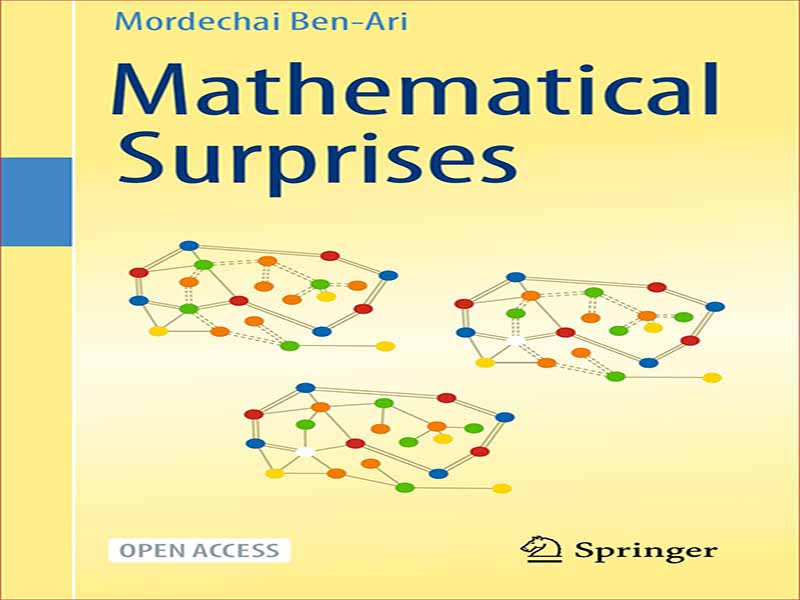- عنوان کتاب: Mathematical Surprises
- نویسنده: Abraham Arcavi
- سال انتشار: 2022
- حوزه: مبانی رباضی
- تعداد صفحه: 232
- زبان اصلی: انگلیسی
- نوع فایل: pdf
- حجم فایل: 2.87 مگابایت
وقتی ریاضیات به درستی مورد توجه قرار گیرد، میتواند شگفتیهای دلپذیر فراوانی را برای ما فراهم کند. این با جستجوی «سورپرایز ریاضی» در گوگل تأیید میشود که در کمال تعجب، تقریباً نیم میلیارد مورد به دست میآید. سورپرایز چیست؟ ریشه این کلمه به فرانسوی قدیم با ریشه های لاتین باز می گردد: “sur” (بیش از حد) و “prendre” (گرفتن، گرفتن، گرفتن). غافلگیری به معنای واقعی کلمه سبقت گرفتن است. به عنوان یک اسم، غافلگیری هم یک رویداد یا شرایط غیرمنتظره یا گیج کننده است و هم احساسات ناشی از آن. به عنوان مثال، عصاره ای از سخنرانی ماکسیم بروکهایمر را در مورد دایره فویرباخ در نظر بگیرید: «دو نقطه روی یک و تنها یک خط مستقیم قرار دارند، این جای تعجب نیست. با این حال، سه نقطه لزوماً روی یک خط مستقیم نیستند و اگر در طول یک کاوش هندسی، سه نقطه در یک خط مستقیم قرار گیرند، این جای تعجب است و اغلب لازم است به این واقعیت به عنوان یک قضیه برای اثبات اشاره کنیم. هر سه نقطه ای که روی یک خط مستقیم نباشد روی یک دایره قرار دارد. با این حال، اگر چهار نقطه روی یک دایره قرار بگیرند، این یک شگفتی است که باید به عنوان یک قضیه فرموله شود. . . . تا آنجا که تعداد نقاط روی یک خط مستقیم بزرگتر از 3 است، این قضیه شگفتانگیزتر است. به همین ترتیب، تا آنجا که تعداد نقاطی که روی یک دایره قرار دارند بزرگتر از 4 است، این قضیه شگفتانگیزتر است. بنابراین، این جمله که برای هر مثلث 9 نقطه مرتبط در یک دایره وجود دارد. . . بسیار تعجب آور است علاوه بر این، با وجود بزرگی شگفتی، اثبات آن زیبا و آسان است.» مردخای بنآری در این کتاب مجموعهای غنی از شگفتیهای ریاضی را ارائه میکند که بیشتر آنها کمتر از دایره فویرباخ شناخته شدهاند و دلایل درستی برای گنجاندن آنها دارند. اولاً، علیرغم غیبت در کتابهای درسی، جواهرات ریاضی این کتاب فقط با پیشزمینه دبیرستان (و صبر و حوصله، و کاغذ و مداد، زیرا تفریح رایگان نیست) در دسترس است. دوم، هنگامی که یک نتیجه ریاضی آنچه را که ما بدیهی می دانیم به چالش می کشد، ما واقعاً شگفت زده می شویم (فصل 1، 13). به همین ترتیب، ما از زیرکی یک استدلال (فصل 2 و 3)، توجیه امکان ساخت هندسی با ابزار جبری (فصل 16)، اثبات تکیه بر موضوعی ظاهراً نامرتبط (فصل 4) شگفت زده می شویم. ، 5)، یک اثبات عجیب از طریق استقراء (فصل 6)، روش های جدید برای نگریستن به یک نتیجه شناخته شده (فصل 7)، یک قضیه به ظاهر جزئی که پایه و اساس یک رشته ریاضیات می شود (فصل 8)، منابع الهام غیرمنتظره (فصل 9)، رسمی سازی های غنی که از فعالیت های صرفاً تفریحی مانند اوریگامی پدیدار می شوند (فصل 10-12). اینها همه دلایل متفاوتی برای گنجاندن شگفتی های ریاضی دلپذیر، زیبا و به یاد ماندنی در این کتاب دوست داشتنی است. تاکنون به چگونگی ارتباط کتاب با بخش اول تعریف غافلگیری، دلایل عقلانی شناختی برای غیرمنتظره ها پرداخته ام. در مورد جنبه دوم، جنبه عاطفی، این کتاب مصداق واضحی است از آنچه بسیاری از ریاضیدانان در مورد دلیل اصلی انجام ریاضیات ادعا می کنند: جذاب است! علاوه بر این، آنها ادعا میکنند که ریاضیات هم کنجکاوی فکری و هم حساسیتهای زیباییشناختی ما را تحریک میکند، و حل یک مسئله یا درک یک مفهوم پاداش معنوی را به همراه دارد، که ما را ترغیب میکند تا روی مسائل و مفاهیم بیشتر کار کنیم. گفته شده است که کارکرد پیشگفتار به خوانندگان می گوید که چرا باید کتاب را بخوانند. من سعی کردهام این کار را انجام دهم، اما معتقدم که پاسخ کاملتر از سوی شما، خواننده، پس از خواندن آن و تجربه آنچه ریشهشناسی کلمه غافلگیری نشان میدهد، به دست میآید: سبقت گرفتن از آن!
Mathematics, when appropriately approached, can provide us with plentiful pleasant surprises. This is confirmed by a Google search of “mathematical surprises,” which, surprisingly, yields almost half a billion items. What is a surprise? The origins of the word trace back to Old French with roots in Latin: “sur” (over) and “prendre” (to take, to grasp, to seize). Literally, to surprise is to overtake. As a noun, surprise is both an unanticipated or bewildering event or circumstance, as well as the emotion caused by it. Consider, for example, an extract from a lecture by Maxim Bruckheimer1 on the Feuerbach circle: “Two points lie on one and only one straight line, this is no surprise. However, three points are not necessarily on one straight line and if, during a geometrical exploration, three points ‘fall into’ a straight line, this is a surprise and frequently we need to refer to this fact as a theorem to be proven. Any three points not on a straight line lie on one circle. However, if four points lie on the same circle, this is a surprise that should be formulated as a theorem. . . . Insofar as the number of points on a straight line is larger than 3, so is the theorem the more surprising. Likewise, insofar as the number of points lying on one circle is larger than 4, so is the theorem the more surprising. Thus, the statement that for any triangle there are nine related points on the same circle . . . is very surprising. Moreover, in spite of the magnitude of the surprise, its proof is elegant and easy.” In this book Mordechai Ben-Ari offers a rich collection of mathematical surprises, most of them less well known than the Feuerbach Circle and with sound reasons for including them. First, in spite of being absent from textbooks, the mathematical gems of this book are accessible with just a high school background (and patience, and paper and pencil, since fun does not come for free). Second, when a mathematical result challenges what we take for granted, we are indeed surprised (Chaps. 1, 13). Similarly, we are surprised by: the cleverness of an argument (Chaps. 2, 3), the justification of the possibility of a geometric construction by algebraic means (Chap. 16), a proof relying on an apparently unrelated topic (Chaps. 4, 5), a strange proof by induction (Chap. 6), new ways of looking at a well-known result (Chap. 7), a seemingly minor theorem becoming the foundation of a whole field of mathematics (Chap. 8), unexpected sources of inspiration (Chap. 9), rich formalizations emerging from purely recreational activities such as origami (Chaps. 10–12). These are all different reasons for the inclusion of the pleasant, beautiful and memorable mathematical surprises in this lovely book. So far I have addressed how the book relates to the first part of the definition of surprise, the cognitive rational reasons for the unexpected. As to the second aspect, the emotional aspect, this book is a vivid instantiation of what many mathematicians claim regarding the primary reason for doing mathematics: it is fascinating! Moreover, they claim that mathematics stimulates both our intellectual curiosity and our esthetic sensibilities, and that solving a problem or understanding a concept provides a spiritual reward, which entices us to keep working on more problems and concepts. It has been said that the function of a foreword tell readers why they should read the book. I have tried to accomplish this, but I believe that the fuller answer will come from you, the reader, after reading it and experiencing what the etymology of the word surprise suggests: to be overtaken by it!
این کتاب را میتوانید از لینک زیر بصورت رایگان دانلود کنید:
Download: Mathematical Surprises




































نظرات کاربران